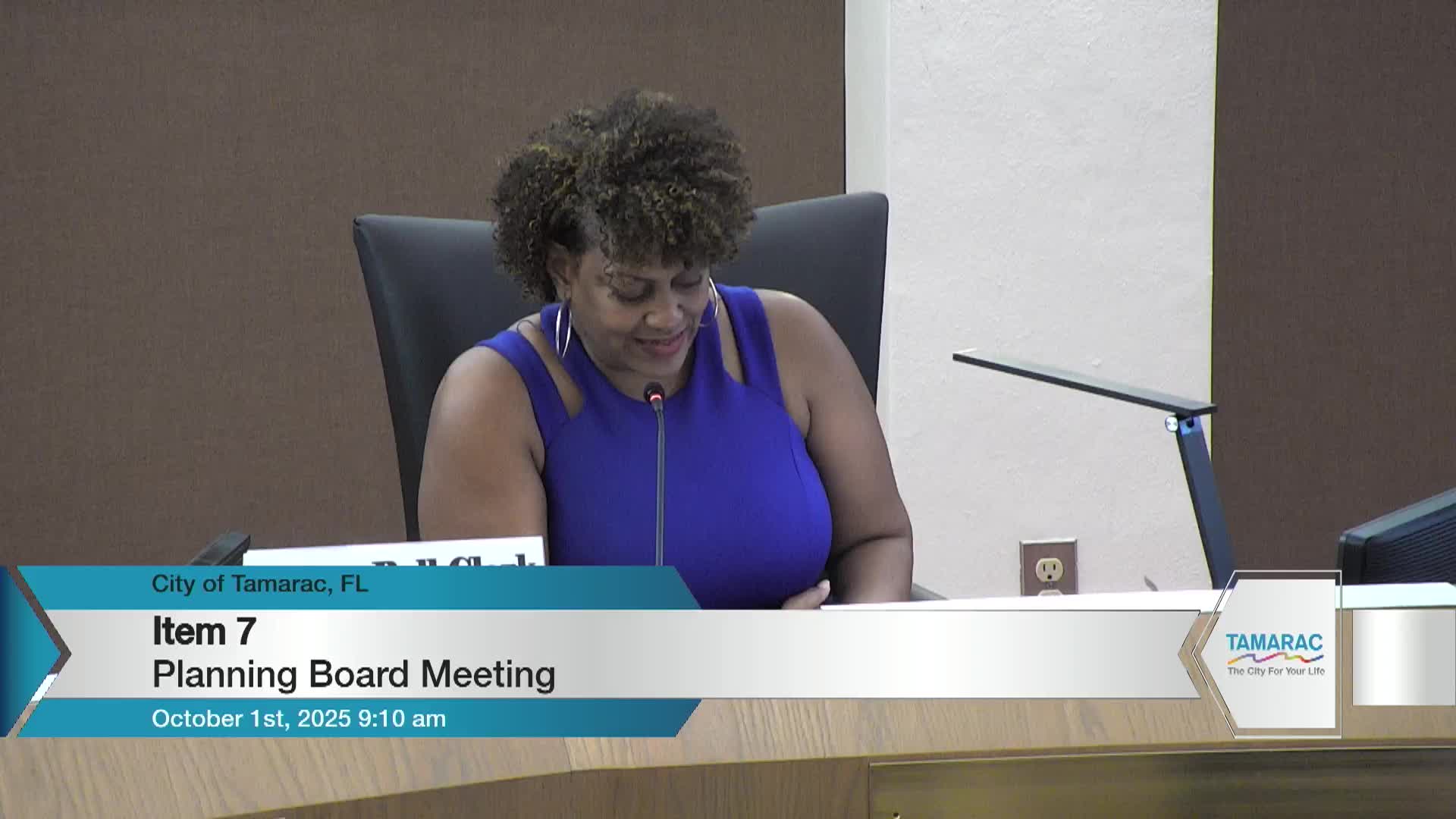Tamarac planning board backs 25% cap on updated impact fees, recommends city commission adoption
October 01, 2025 | Tamarac, Broward County, Florida
This article was created by AI summarizing key points discussed. AI makes mistakes, so for full details and context, please refer to the video of the full meeting. Please report any errors so we can fix them. Report an error »

The Tamarac Planning Board on Wednesday unanimously recommended the City Commission adopt a temporary ordinance to update the city's development impact-fee program, endorsing staff's recommendation to implement a 25% increase in fees in a two-year, phased schedule.
The proposal, presented by the city's consultant, Carson Vice of TischlerBise, would revise fees for parks and recreation, governmental facilities and multimodal transportation and simplify nonresidential fee categories into five broad groups. "It's not a tax, but more like a contractual arrangement to provide infrastructure," Vice said while explaining the legal tests that an impact-fee study must meet.
The board was presented a ten-year growth projection the consultant used to establish need and proportionality: roughly 6,300 more residents, about 3,000 new housing units, about 1,540 new jobs and about 650,000 square feet of additional nonresidential floor area over the next decade. The consultant recommended increasing fee levels by up to 25% rather than adopting the larger maximums the study would allow; the recommendation was framed as preserving competitiveness while meeting legal requirements.
Under the recommended schedule, parks fees would be assessed only on residential development and would cover parkland, park improvements and community centers. Governmental facilities fees would apply citywide to both residential and nonresidential development and include land and building costs. Multimodal transportation fees would fund sidewalks, bike lanes, shared paths and related pedestrian-scale improvements rather than major arterial expansions.
Carson Vice said the study also compresses many current nonresidential categories into five types'commercial, institutional/office/other service, general industrial and warehousing'to reduce punitive effects on certain uses and to ease economic recruitment. The ordinance will allow applicants the option of independent fee calculations if they can demonstrate a different proportional impact.
Board members asked how collected fees could be used. The consultant and staff said state statute limits impact-fee spending to defined public facilities and precludes using these fees for business or general housing development; however, the city uses separate tools and incentives, such as density bonuses and other local mechanisms, to encourage affordable housing outside the impact-fee program.
Vice showed draft fee numbers in the presentation. Examples cited by staff included government-facility fees ranging roughly from $359 for certain multifamily senior units to $966 for the largest single-family units in the draft schedule. Staff recommended a 25% increase across the board instead of adopting the statute's higher maximums, which would require additional procedures.
After questions, the board voted 4-0 to forward a favorable recommendation to the City Commission. Planning staff said the temporary ordinance and revised schedule would come before the commission for consideration as the next step.
The planning board record of the item will go to the City Commission for final action and codification if the commission votes to adopt the ordinance.
The proposal, presented by the city's consultant, Carson Vice of TischlerBise, would revise fees for parks and recreation, governmental facilities and multimodal transportation and simplify nonresidential fee categories into five broad groups. "It's not a tax, but more like a contractual arrangement to provide infrastructure," Vice said while explaining the legal tests that an impact-fee study must meet.
The board was presented a ten-year growth projection the consultant used to establish need and proportionality: roughly 6,300 more residents, about 3,000 new housing units, about 1,540 new jobs and about 650,000 square feet of additional nonresidential floor area over the next decade. The consultant recommended increasing fee levels by up to 25% rather than adopting the larger maximums the study would allow; the recommendation was framed as preserving competitiveness while meeting legal requirements.
Under the recommended schedule, parks fees would be assessed only on residential development and would cover parkland, park improvements and community centers. Governmental facilities fees would apply citywide to both residential and nonresidential development and include land and building costs. Multimodal transportation fees would fund sidewalks, bike lanes, shared paths and related pedestrian-scale improvements rather than major arterial expansions.
Carson Vice said the study also compresses many current nonresidential categories into five types'commercial, institutional/office/other service, general industrial and warehousing'to reduce punitive effects on certain uses and to ease economic recruitment. The ordinance will allow applicants the option of independent fee calculations if they can demonstrate a different proportional impact.
Board members asked how collected fees could be used. The consultant and staff said state statute limits impact-fee spending to defined public facilities and precludes using these fees for business or general housing development; however, the city uses separate tools and incentives, such as density bonuses and other local mechanisms, to encourage affordable housing outside the impact-fee program.
Vice showed draft fee numbers in the presentation. Examples cited by staff included government-facility fees ranging roughly from $359 for certain multifamily senior units to $966 for the largest single-family units in the draft schedule. Staff recommended a 25% increase across the board instead of adopting the statute's higher maximums, which would require additional procedures.
After questions, the board voted 4-0 to forward a favorable recommendation to the City Commission. Planning staff said the temporary ordinance and revised schedule would come before the commission for consideration as the next step.
The planning board record of the item will go to the City Commission for final action and codification if the commission votes to adopt the ordinance.
View full meeting
This article is based on a recent meeting—watch the full video and explore the complete transcript for deeper insights into the discussion.
View full meeting